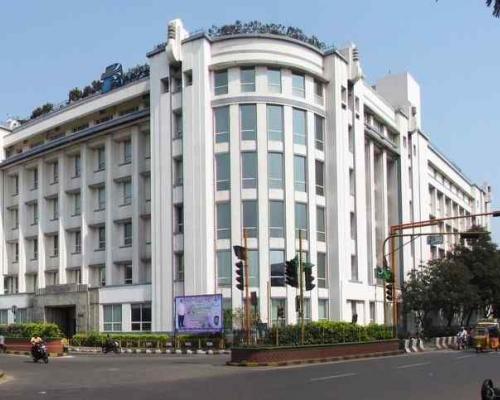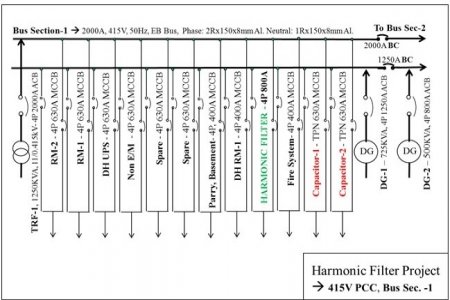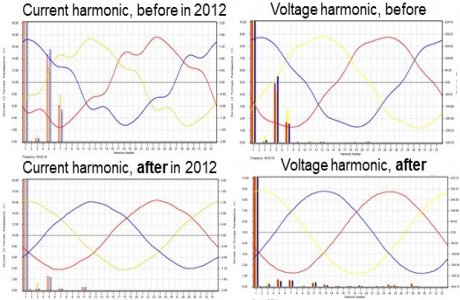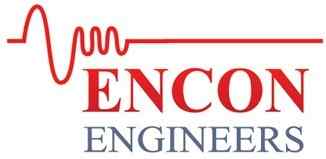
Intelligent Building eliminates UPS and Elevator failure
How to troubleshoot the extraordinary equipment failure, electrical fire and occupants' safety issue in a building? Read this case study how building harmonic filter fixes light flicker & UPS tripping with grid voltage fluctuation. How harmonic causes electronic card failure and creates trouble with elevator operation. The quality of the incoming power supply from the utility grid carries crucial performance parameters for the building equipment.
Why UPS fails to mitigate incoming voltage fluctuation
Though it's not at the hand of building engineers, they have engineering tool to condition the incoming power quality. UPS powers critical building loads, namely work station computers, corporate data center servers and emergency lighting. Many wonders why sensitive equipment powered by UPS fails on voltage fluctuation? Why emergency lighting at the UPS output supply flickers on grid voltage dip? UPS is not a power conditioner but more of a convenience. It can only condition the steady-state voltage profile. UPS can't mitigate momentary voltage transient and power surge, which typically lasts in milliseconds, and passes those to output supply in the form of DC ripples.
Building's power quality problems and how to improve it
 Murugappa Group is South India's largest business conglomerate. Its corporate office is a 6-story heritage building built-in 1932 (dare house) and extended in 1950 (parry house and dare house extension). Its total area is 250,000 Sq.Ft. It accommodates 1300 corporate employees. The group has diverse business activities in engineering, finance and leisure sectors; namely automobile, abrasive, OEM component manufacturing, fertilizer, sugar, food, finance, insurance, travel and tourism. Two nos dry-type transformers, each 1250kva, 11kv/415v, power the building through two LT PCC each in double bus bar configuration and one harmonic filter as shown in Bus Sec-1 SLD. The capacitor APFC panels removed after installation of harmonic filter which apart from controlling harmonics and troubleshooting failures, maintained PF at 0.99, consistently.
Murugappa Group is South India's largest business conglomerate. Its corporate office is a 6-story heritage building built-in 1932 (dare house) and extended in 1950 (parry house and dare house extension). Its total area is 250,000 Sq.Ft. It accommodates 1300 corporate employees. The group has diverse business activities in engineering, finance and leisure sectors; namely automobile, abrasive, OEM component manufacturing, fertilizer, sugar, food, finance, insurance, travel and tourism. Two nos dry-type transformers, each 1250kva, 11kv/415v, power the building through two LT PCC each in double bus bar configuration and one harmonic filter as shown in Bus Sec-1 SLD. The capacitor APFC panels removed after installation of harmonic filter which apart from controlling harmonics and troubleshooting failures, maintained PF at 0.99, consistently.
The quality of power, which lies in momentary transients, does not better with the installation of UPS. Triplen filter is the engineering tool build for mitigating the momentary power surge, be it voltage fluctuation, unbalance, high neutral current and neutral voltage. In this building, 3x60kva UPS in parallel powered the corporate data centre servers for pan India and global operation, and 2x60kva UPS in parallel powered the work stations. Electronic cards, SPMP and hard disk drives were failing from bad power-quality. A Sudden dip in utility grid voltage used to cause flicker on floor lighting and simultaneously trip UPS incomer main supply breaker/ MCCB. When the main building supply is uninterrupted but the UPS incomer trips; it's both tricky and alarming. UPS battery drains out in 30 to 40 minutes unless at every trip someone notices it and switches on the circuit breaker at the UPS incomer. Building automation is not fool-proof against bad power-quality. Elements of the SCADA system hangs and needs a reset.
By creating a bonding through an intertwined magnetic flux path, Triplen filter not only equalizes three-phase currents and voltages but opposes any change of power system parameters from the equilibrium state. It prevents sudden voltage variation and conditions the quality of incoming power supply by eliminating transient surges, improving three-phase unbalance and removing neutral current and neutral voltage. We installed one 120A/phase and 240A/neutral Triplen filter at the main incomer of 3x60KVA Data Center Server UPS and another 80A/phase and 160A/neutral Triplen filter at the main incomer of 2x60KVA workstation UPS. It mitigated the lighting flicker whose dimming intensity (dip in Lux level) and frequency of occurrence reduced substantially. The UPS tripping problem got eliminated. Besides, the building's total neutral current at 1250kva, 11/0.415kv transformer at 415V Main MV Panel got reduced, triplen filter removes neutral current by 70 to 90% depending upon the fault level of the electrical power system.
Elevator problems a building face and how to solve it
The building has over half a dozen guest and service elevators, installed from diverse OEM companies. It was facing a series of extraordinary elevator problems and failures.
1. It randomly malfunctioned, went to the wrong floor.
2. It had repetitive burn out issues with Electronic Components, Circuit Boards, Relays and PCB Cards.
3. The automatic lift door got jammed or slammed shut.
4. The elevator's floor landing was not in alignment with the floor level.
5. It had frequent breakdown problem wherein it used to get stuck in an arbitrary position trapping occupants inside. Often, it used to happen after a power failure or while experiencing a brownout condition.
One may be curious to know why modern buildings which employ automated building management solutions and smart elevators, can't achieve self-resetting with elevator operation? Well, elevators restart pretty efficiently on a sudden power outage that remains off for a length of time, typically 20 seconds. But in case of a brownout situation the incoming voltage sags or slumps. It spikes the current drawn by critical and expensive elevator electronics and electrical equipment, which could lead to failure. For the elevator manufacturer, there is a trade-off between equipment safety and excessive nuisance tripping. Crossing the threshold, the elevator's electrical protection system passes on to assisted reset mode with three options.
1. Power system reset wherein a simple power on and off does the job and the elevator comes back to service.
2. Software reset involves a software corruption that requires OEM service team to reset or reload the software.
3. Breakdown reset involves a complex scenario wherein the manufacturer's knowledgeable technician inspects and replaces the faulty components before restarting the elevator.
We installed one elevator triplen filter, 10A/phase and 20A/neutral, for each affected elevator at its main power incomer in the lift room. It resolved all elevator issues.
How to assess Electrical Fire Risk and its prevention measures
When it comes to electrical fire risk assessment of a building, there arise six questions which determine the correlational root cause analysis of the fire incident.
1. How did the electrical fire seem to have ignited?
2. Where, in the building, the fire started first?
3. Did the fire spread too quickly, if yes, why so?
4. Did the fire start from multiple locations in the facility?
5. Did the fire originating spot(s) have high energy intensity load(s)?
6. Is this a sophisticated, intelligent building with modern gadgets or a conventional building?
Once we have sufficient answers and clarity on the first two questions, the likely reason for the fire is simple, either worn out installation or negligence. The possible causes could include worn out or undersized electrical wiring, faulty electrical receptacles switches or outlets, weary appliances, worn-out light fittings or unrestricted use and haphazardly placed extension cords or loosely connected gadgets.
If, however, the questions are beyond the first two, the reasons could be varied, and only an experienced electrical engineer can get to the bottom of the problem and troubleshoot its further recurrence. Nonetheless, attributing electrical short circuit as a cause for every building fire is an invention of the press, television and entertainment media, social media and newspapers. The probability of an electrical short circuit fire is pretty low, anyway. High neutral current is a major-reason for igniting an electrical fire, anywhere in a building, at multiple locations along with the building's electrical power system. It's a technological fire incident. The modern and high tech buildings are not only susceptible to it but their sophisticated electrical and electronic gadgets and LED lights generate triplen harmonics which triple at neutral and create a high neutral current. Triplen harmonic filter by removing the neutral current from the building's electrical power system, greatly-eliminates the electrical fire risk.
Harmonic Filter an extraordinary troubleshooter for building
 Following the collapse of several grid sections in India, TNEB, a local utility company has mandated limiting harmonics starting 2012 as per Govt of India's "CEA regulation 2007 for grid connectivity" which in turn is as per IEEE 519 standard. It is difficult to deconstruct the root cause of a grid collapse. Even after decades, no convincing reason has emerged from the American grid collapse. Grid collapses when multiple reasons swell-up cascading one after another and reach the threshold trigger point.
Following the collapse of several grid sections in India, TNEB, a local utility company has mandated limiting harmonics starting 2012 as per Govt of India's "CEA regulation 2007 for grid connectivity" which in turn is as per IEEE 519 standard. It is difficult to deconstruct the root cause of a grid collapse. Even after decades, no convincing reason has emerged from the American grid collapse. Grid collapses when multiple reasons swell-up cascading one after another and reach the threshold trigger point.
Power quality harmonic is a predominant specification that defines a stable grid. It prevents the grid from a sudden collapse by relieving it together with connecting generating stations from the cascading effects of a possible built-up of a stressful power system condition. Furthermore, electrical harmonics are unpredictable, and under a favourable power system impedance, trigger harmonic resonance magnifying harmonics, voltage fluctuations and power surge.
Building harmonic filter increases maintenance efficiency and enhances building valuation by extending asset life by eliminating failures in HVAC motors, VFD drives, Switchgears, LED lights, SMPS, UPS input cards, Lift (Elevator) VFD cards and Electronic gadgets. The harmonic filter replaces capacitor APFC panel which anyway has a short life besides it magnifies harmonics. The Total Current Harmonic Distortion (THDi) and Total Voltage Harmonic Distortion (THDv) was 20% and 7% respectively at Bus Sec-1 with high waveform distortions during the initial harmonic measurement in 2012. The harmonic filter mitigated both THDv and THDi within acceptable limits of IEEE 519 standard and reconstructed both voltage and current waveforms back to sinusoidal. Besides, the harmonic filter project eliminates the need for equipment derating and removes barriers to energy efficiency, which saves equipment footprint and energy consumption for the building.


















